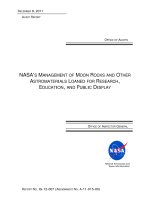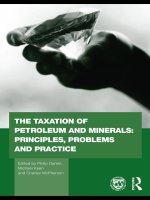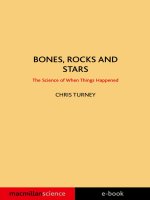2014 09 08 rocks and minerals fall2014
Bạn đang xem bản rút gọn của tài liệu. Xem và tải ngay bản đầy đủ của tài liệu tại đây (2.08 MB, 35 trang )
Rocks
and
Minerals
8 September 2014
Rocks and Minerals: Definitions
– A mineral is solid inorganic material of the Earth that
has both a known chemical composition and a
crystalline structure that is unique to that mineral
– A rock is a solid aggregate of one or more minerals that
have been cohesively brought together by a rockforming process.
Earth Interior: Physical
Minerals
the building blocks of rocks
Mineral Characteristics
• natural
• inorganic
• solid
• definite composition
• crystal structure
Mineral Composition
Minerals are grouped or classified based on
their composition. There are 6 groups
1. Carbonates - contain
carbon, oxygen, and one
ore more metallic element
2. Silicates
- formed from silicon and
oxygen
- elements combined to
form a silicon
tetrahedron, 1 silicon
atom and 4 oxygen atoms
- formed from cooling
magma
- either near the surface
(few crystals) or deep
below surface (larger
crystals)
3. Oxides
- Minerals that
contain oxygen and
one or more other
element(s)
4. Sulfates and
Sulfides
Gypsum
- Minerals containing
sulfur
Pyrite
5. Halides
-minerals containing
halogen ions plus
one or more other
elements
Halite
6. Native Elements
Minerals that exist in
a relatively pure
form
i.e. Gold, silver,
copper
Gold crystal structure
Rocks
– Elements are chemically combined to form minerals
– Minerals are physically combined to form rocks.
Igneous Rocks
• Magma- molten material underground
• Lava- magma that reaches the surface
• Igneous rocks are formed from magma that
has cooled and hardened either beneath the
surface or from a volcanic eruption
2 Ways to Form Igneous Rock
• Intrusive Igneous
Rocks- form when
magma hardens
beneath Earth’s
surface
• Magma intrudes into
existing rocks
• Extrusive Igneous
Rocks- form when
lava hardens on the
surface of the Earth
• Extruded onto the
surface
rhyolite
granite
• Magma contains some gases, including
water vapor- this make it less dense, so it
rises
• As magma rises, it cools and forms crystals
• The longer the cooling time the larger the
crystals
• Granitic Composition- contain
mainly quartz and feldspar,
some with biotite mica and
amphibole. Make up major
rocks of continental crust
• Basaltic Composition- contain
mainly dark colored minerals
and feldspar, along with Mg
and Fe. Darker and denser than
granitic composition
Igneous rock classification scheme based on mineral
composition and texture. There are other blends of minerals
with various textures, many of which have specific names.
Granite is a coarse-grained igneous rock composed mostly
of light-colored, light-density, nonferromagnesian minerals.
The earth's continental areas are dominated by granite and
by rocks with the same mineral composition of granite.
This is a piece of obsidian, which has the same chemical
composition as the granite. Obsidian has a different texture
because it does not have crystals and is a volcanic glass. The
curved fracture surface is common in noncrystalline
substances such as glass.
Sedimentary Rocks- formed from
compacted and cemented sediments
• Weathering physically and chemically
breaks rocks into small pieces called
sediments
• Sediments are moved
by wind, water, ice,
and gravity
• Eventually, they are
dropped and form layers
that are cemented together
Weathering, Erosion, and
Deposition
• Weathering breaks
rocks down
• Erosion involves
weather and the
removal of rock
• Deposition is the
dropping of sediments
• Sediments are
deposited according to
size
Compaction and Cementation
• Compaction is the
process that squeezes
the water out of the
sediments. It is caused
by the weight of the
sediments.
• Cementation takes
place when dissolved
minerals are deposited
in the tiny spaces among
the sediments.
• Cementing holds the
sediments together.
Classification of Sedimentary
Rocks- based on formation
• Clastic Sedimentary
• Chemical
Rocks are formed
Sedimentary Rocks
from weathered bits of
are formed when
rocks and minerals
dissolved minerals
precipitate from water
• Grouped according to
solution
size of the sediments
Coquina
in the rock
limestone
• Sedimentary rocks hold many clues to the
Earth’s history
• Layers of sediments are records of geologic
events on Earth
• Fossils are unique to sedimentary rocks
This is a sample of breccia, a coarse-grained
sedimentary rock with coarse, angular fragments.
Compare the grain sizes to the centimeter scale.









